With all the different information out there, how are you EVER supposed to decide on the right food photography lenses? A camera lens isn’t a cheap purchase, so you want to make sure you’re making the right investment that’s going to last you. And that’s exactly what today’s video and post are going to help you with!
We’ll start off looking at the key features of food photography lenses, before diving into some food photography lens examples and recommendations. Let’s go!
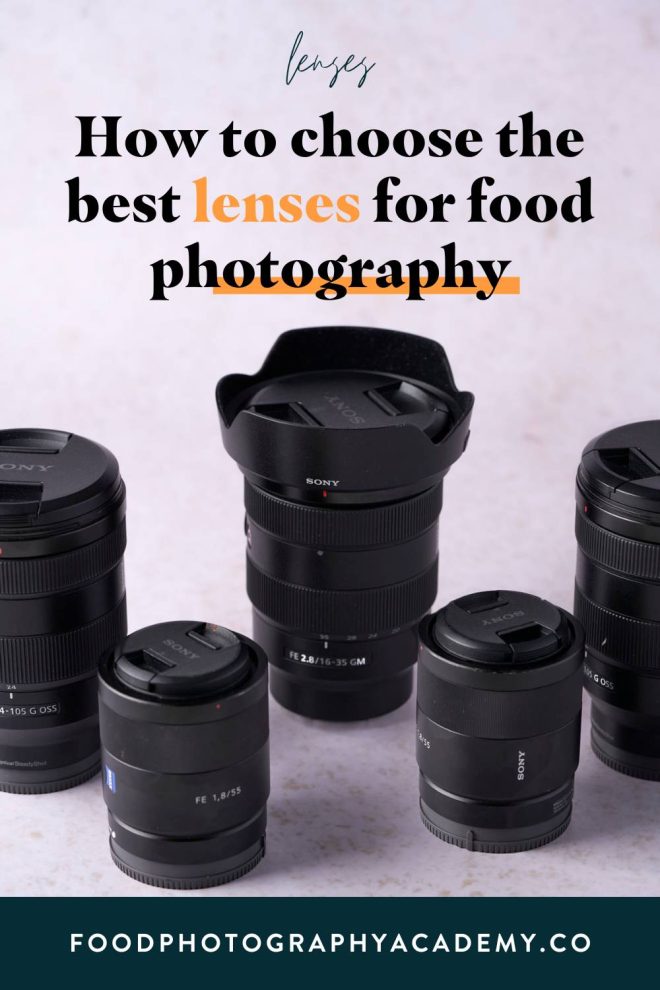
This post is part of my Ultimate Food Photography Lens Guide, check out the full guide now!
By the end of this series you’ll understand how different lenses behave on different cameras, what impact this will have on your food photography, and ultimately what lens (or lenses) you need to achieve the result you want.
Remember, the trick to deciding on the best lens (or lenses) for your food photography is to understand what you’re trying to achieve in your photos, and knowing what kind of lens will help you achieve that. Your food photography composition is heavily reliant on using the right lens for the job.
Stop guessing and start implementing with my foolproof composition system. Elevate your food photography from good to great with composition techniques.
Free Resource
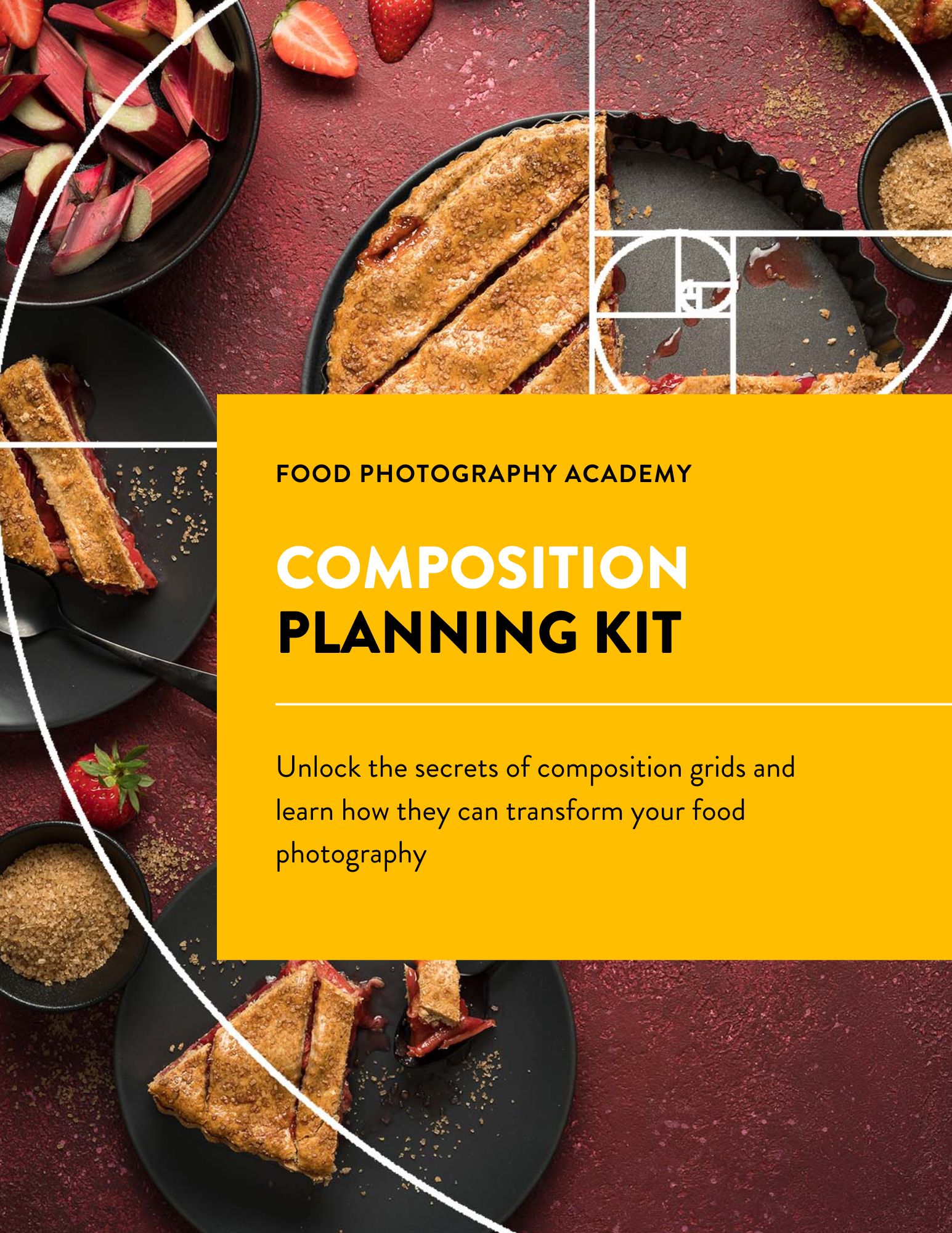
What to consider when choosing a food photography lens
As we saw in this post, focal length is the KEY feature of a lens that will affect the composition of your food photo the most. You can plan the perfect layout of props, backgrounds and style your food perfectly, but if you’re using the wrong lens for the job, you will never get the look you want.
As well as focal length, here are four other main features that you should consider:
- Is it a prime lens or a zoom lens?
- What is the maximum aperture?
- Is it a macro lens?
- What’s the optical quality of the lens
We’re going to take a look at some food photography examples taken on different lenses later in this post, but first, let’s run through the basics.
Prime vs zoom lenses
A prime lens has a fixed focal length, so if you buy a 50mm lens, it’s a 50mm lens all the time.
A zoom lens has a range of focal lengths, for example 18-55mm, so you can change the focal length to suit the situation you’re in.
Typically, for food photography, prime lenses are better quality than zoom lenses, and here’s why:
Aperture
Because the internal structure of a prime lens is simpler and involves less glass, prime lenses usually have wider aperture capability (a lower F-stop number), allowing you to achieve a narrow depth of field in your images.
Sharpness
Nearly always, a prime lens is sharper than a zoom lens. This is because a prime lens has a less complicated structure, and therefore it can focus on being a great lens at one focal length, rather than a good lens at lots of different focal lengths.
Tack sharp photos will always elevate your food photography from good, to great. This doesn’t mean zoom lenses are bad, so if your budget allows for one good zoom lens versus three prime lenses, get the zoom lens!
Stop guessing and start implementing with my foolproof composition system. Elevate your food photography from good to great with composition techniques.
Free Resource

The maximum aperture of the lens
When we’re talking about how “fast” a lens is, we’re talking about how wide open the aperture ring can go. The lower the F-stop number, the wider your aperture, and the more bokeh (that nice background blur) your image will have.

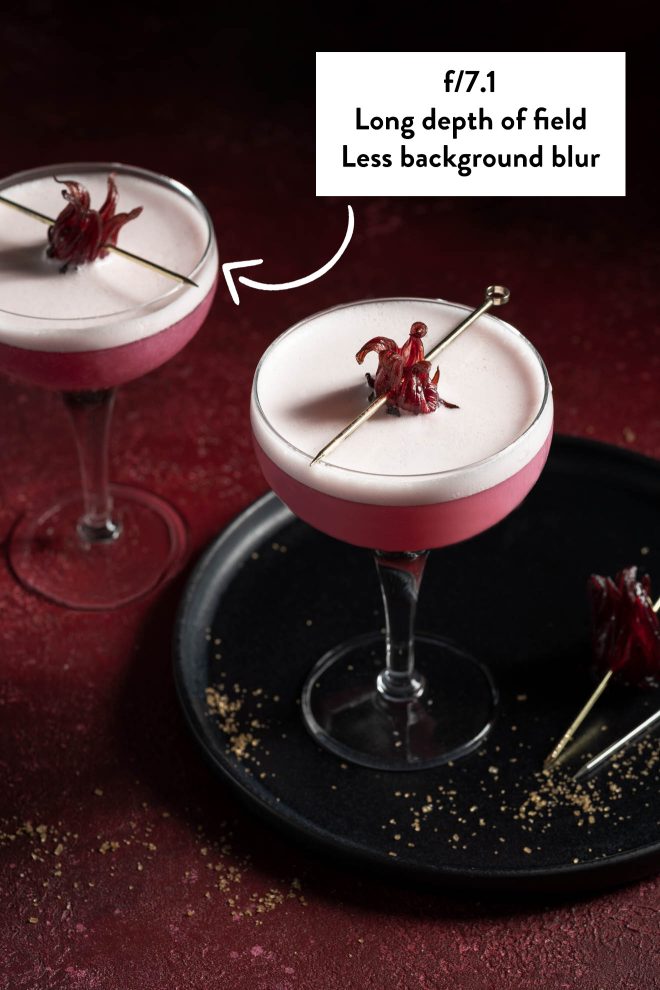
Each lens will have a maximum aperture, which is the “f/x” number that’s part of the lens description. So a “50mm f/2.2” lens, has a maximum aperture of f/2.2.
In food photography, I normally shoot between f/3.5 – f/8, but occasionally I’ll use a higher F-stop number (a smaller aperture opening) if I want everything in the frame to look sharp (for example for product photography).
Most zoom lenses have a smaller maximum aperture opening (meaning a higher F-stop), particularly when extended to their longest focal length. This means you may find yourself limited in some situations such as low light if you only have a zoom lens.
Macro (or Micro) lenses
A macro lens has a magnification factor of 1.0x or 1:1, which allows it to reproduce a life sized image of your subject on the camera’s sensor. This means you can get really really close to something and it will still be in focus.
Read the full guide on lenses for macro food photography here.
Optical quality
The optical quality really depends on the specific makeup of each lens. It isn’t something that you’ll usually find in the lens description, so you’ll need to do a bit of your own research.
A lens with a better optical quality will usually take sharper images with fewer optical issues, such as distortion and chromatic aberration.


You can often save money (and improve quality) by buying a camera body on it’s own, and buying a better lens separately, rather than buying your camera with the kit lens.
TIP: If you’re considering buying a lens and want to know the quality of the photos it produces, The Digital Picture is my go-to to see examples and compare the quality of different lenses. I’ve used it every time I’ve bought a new lens.
And don’t forget… your lens has one of the biggest impacts on your composition! Download my free printable food photography composition kit below to start planning your images like a pro.
Stop guessing and start implementing with my foolproof composition system. Elevate your food photography from good to great with composition techniques.
Free Resource

Food photography lens examples
Let’s take a look at how different kinds of lenses can be used to achieve the style you want. Important note: The lenses I’ve linked are all Canon, so if you want to purchase a lens of that focal length, make sure you get the correct brand lens for your camera!
The Wide Angle (10mm – 50mm)
Great for:
Wide overhead food photography scenes
Crop sensor shooters who want to shoot flat lays
Food Video
Drawbacks: Wide angle lenses can have issues with perspective distortion (particularly barrel distortion) when they’re used too close to the subject. They aren’t ideal for straight on, or close up shots in food photography.

Recommendation for Crop Sensor Shooters
18-55mm zoom lens
24mm prime lens
Recommendation for Full Frame Shooters
24-70mm zoom lens
35mm prime lens
50mm Focal Length (the “nifty fifty”)
You have probably heard nearly everyone mention the “nifty 50”. The reason why, is that a 50mm focal length makes a pretty good all round lens in food photography. It’s a lens that I reach for really often
Great for:
Straight-on or 45° angled shots where you want to capture a subject and leave some negative space around the food.
Overhead flat-lay, top down food shots of table settings.
Drawbacks:
You still might get SOME perspective distortion with a 50mm focal length, where lines of perspective in the photo are a bit too dramatic. If you’re also using this primarily for top down shots, you may struggle to get high enough above your table to capture everything in the frame.
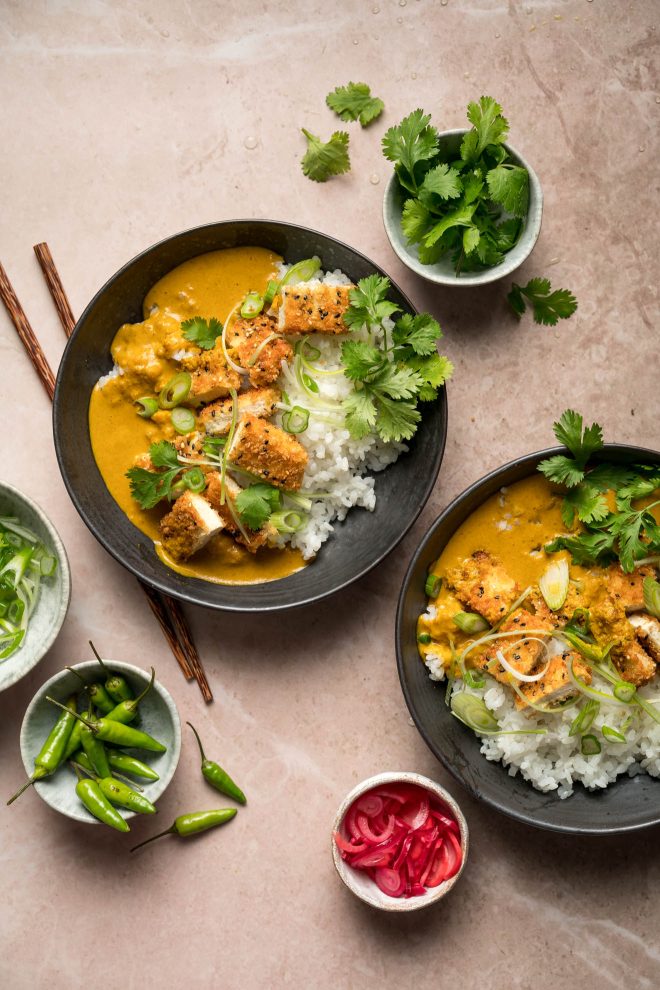
Recommendations for crop sensor shooters
35mm prime
Recommendations for full frame shooters
50mm prime
A Long-Focus (telephoto) Lens (60mm upwards)
This is my most used go-to lens for food photography. I personally have a long focus lens that is also a macro lens, gives me the double benefit of being able to take very close up texture shots, and a short minimum focus distance for 45° food portrait shots.
Great for:
25°-75° angle shots and straight on shots.
Food portraiture
Close up shots
Drawbacks:
Can’t be used as easily for overhead food photography shots (although it can be beautiful), as you have to be very high above the scene to get everything in the frame. A big consideration for this lens is whether you have enough space to get everything in the frame, or if you have a tripod tall enough to take cropped overhead shots.
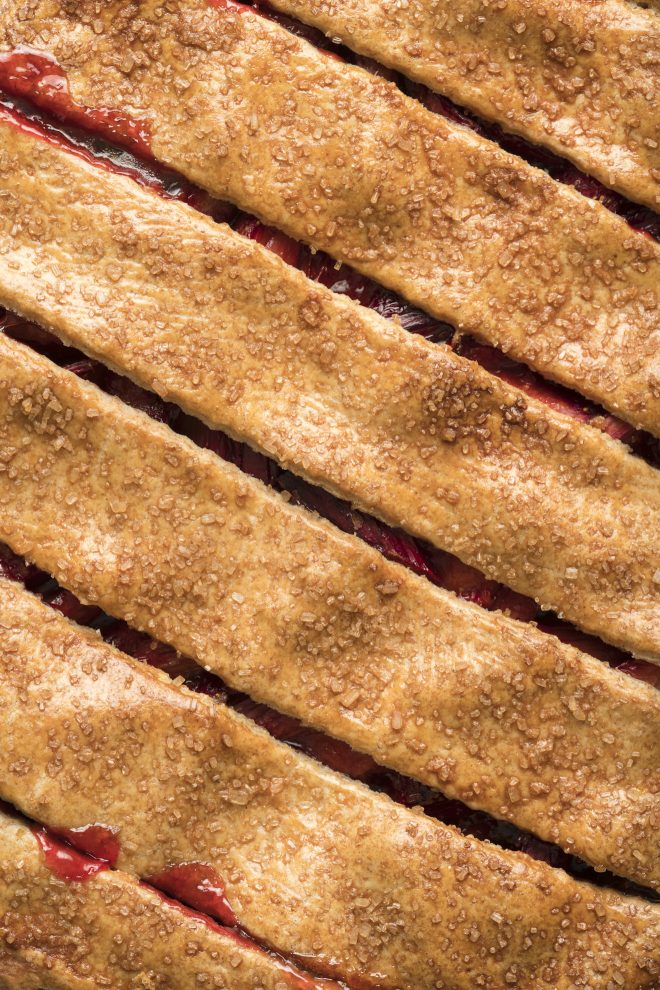
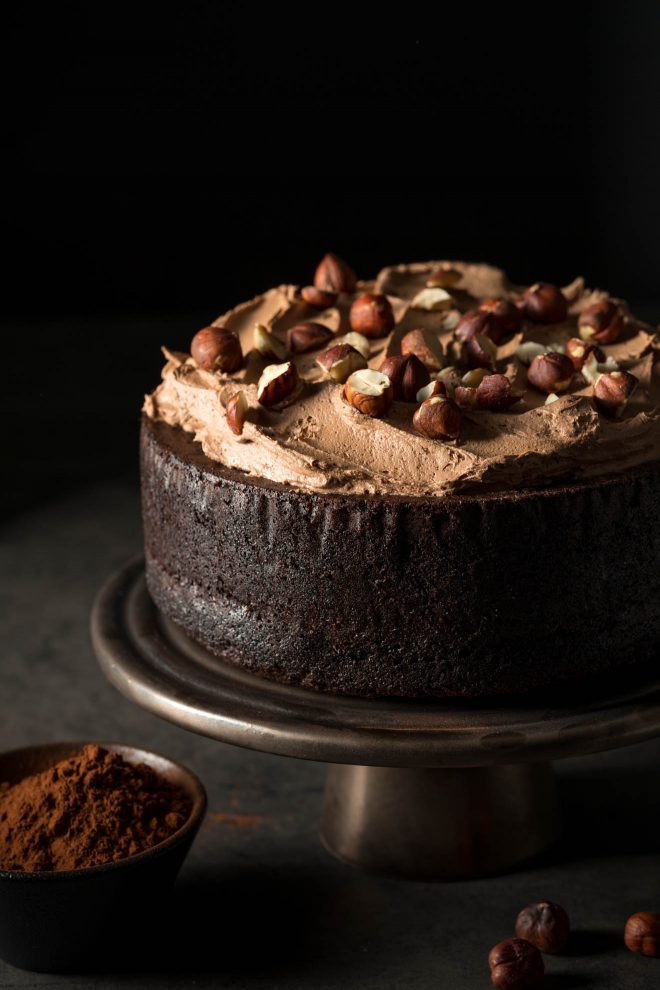
Recommendations for crop sensor shooters
60mm macro
Recommendations for full frame shooters
90mm macro
100mm/105mm macro
Macro Lenses for Food Photography
Macro lenses are a special type of lens that allow you to focus very close to a subject, allowing us as food photographers to create some really special shots. They need a whole post in themselves, so as part of this guide you can read my complete guide to macro lenses for food photography.
I do recommend buying a longer focal length lens that is also a macro lens, so you get the benefit of both in one.
A Zoom Lens
A zoom lens is a great addition to your food photography lens kit, to cover focal lengths you don’t use often enough to justify buying another prime lens for. I just personally wouldn’t have it as the only lens in my kit as a replacement for a prime lenses, but this doesn’t mean that it couldn’t be the best choice for you.
Great for:
Performing the function of multiple kinds of lenses (from wide-angle to long-focus).
Drawbacks:
While you can save money getting a zoom lens instead of multiple different primes, you may find you’re not always able to get your food looking as sharp and vibrant because of a slightly lower optical quality. The maximum aperture is often more limited too.
Recommendations for crop sensor shooters
16-35mm
18-55mm
Recommendations for full frame shooters
16-35mm (for video / wide angle work)
24-70mm
Bonus Lens: the tilt shift
A luxury for food photographers. A tilt shift lens allows you to control the plane of focus, as well as the angle and position of the subject.
I don’t have a tilt shift lens in my kit yet, it’s on my list for (much) later.
I won’t go into all the technical details of a tilt shift lens now, but once I’ve got one and can shoot some food pictures and show you exactly how it works, I’ll do a post on it.
Ultimately, the right lens is going to help you produce the best composition you can. To help you get started, I’ve got a free
Stop guessing and start implementing with my foolproof composition system. Elevate your food photography from good to great with composition techniques.
Free Resource

Deciding on your perfect food photography lens
Now you know all the key features to look out for when deciding on your food photography lenses, it’s time to put all that awesome knowledge to good use and decide on the lens, or lenses, you want!
And to make it even easier, here’s the exact process I’ve gone through to choose my food photography lenses:
- Decide on the style of food photography that you want to take
- Work out the focal length you’ll need to take these photos (being aware of whether you have a crop sensor or full frame DSLR)
- Think about the other features that you’ll need from the lens, e.g. maximum aperture, how much space you have to shoot in, etc.
- Do some googling to find lenses for your camera that have these features and are within your budget
- Check out some reliable camera review sites, such as The Digital Picture, to see if the lens comes up to scratch!
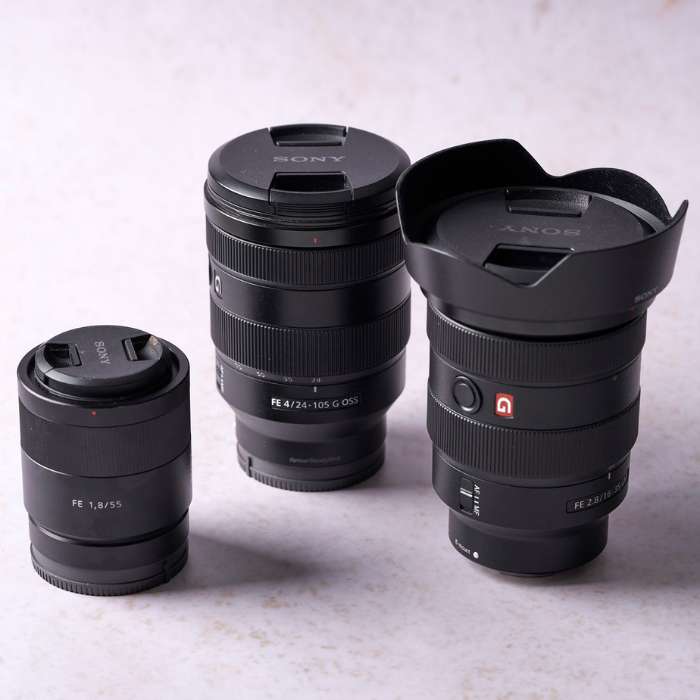
Your photography is amazing, I am really impressed with the guidelines.
Amazing guide, thank you!
Nice post
Excellent presentation on the material. But one MIIIINOR nitpick (for the audience). “prime lenses normally have wider aperture capability (a lower F-stop number), allowing you to great greater depth of field in your images.” The lower f-stop (wider aperture) should (unless I’m somehow mistaken) produce a narrower depth-of-field. (based on your other material, I’m assuming this was a typo or artistic labeling). I would imagine the f/1.2 or f/1.4, in general, is going to be overly blurry outside of the focal plane. e.g. only one strawberry out of the batch will be crystal-clear. Artistically this can be awesome (if composed well), but,… Read more »
Hi, you are indeed correct! I guess I worded this part confusingly. What I meant, was you get a greater range of aperture capability with a prime, but using the word wider to describe this was misleading!
Hi Lauren,
I’ve been struggling with distance on my “nifty fifty”, without putting food on the floor, I can’t get enough distance on my overhead shots. My Nikon has a 1.5 crop, do you think I should be looking at the 60mm Micro AF-S f/2.8?
Thanks!
I’ve had this same issue. I just got a Nikon 35mm 1.8 and I love it. I wish I had gotten it sooner. Its perfect for overhead shots and is a lot truer to a 50mm than an actual 50mm lens which is 75mm on a Nikon crop sensor camera. I have the 60mm macro as well. I wouldn’t use it for overhead shot unless you have the room or you’re taking a really close up shot. It will act like a 90mm on a crop sensor. It works beautifully for head shots thought. It’s pricy but I hight recommend… Read more »
My favorite lens for cooking photography is Canon 100mm f / 2.8L IS USM Macro – there is no better lens!
Sounds great!
Hi Lauren ! Thanks for all these great infos on the lenses. I never realized I must take into account the “cropped sensor factor” and convert the focal length. In step 1 I thought I needed the 50mm to achieve the result I want but now I’m wondering if I should get the 35mm instead…
Hi Valerie! Yes indeed there’s a lot that goes into choosing a lens. If you’re on a crop sensor and want a “nifty 50” then something around a 35mm would suit you 🙂 Glad you found the post useful!
Hi, your posts have been super helpful! Why did you go with Sigma’s 35mm lens as opposed to Canon’s? I have an 80D as well, so I’d be curious to know.
For me it just came down to the details. I used a super awesome lens comparison tool (https://www.the-digital-picture.com/Reviews/ISO-12233-Sample-Crops.aspx) to really look in detail at the lens performance in many different situations, and the Sigma trumped it. The art series lenses really are beautiful! Plus it was a whole lot cheaper than Canon’s version (and it’s important not to get too hung up on brand names 😉 )
Hi
How about macro lens. R they good for food photography? If yes which one 50mm or 100mm?
Thnx
Hetal
Hi Hetal!
Yes I love using a Macro lens, right now mine is a 60mm (so acts like a 90 (ish)mm on my crop sensor. I don’t tend to use it as a super up close lens, but I like the 1:1 capabilities!
Hi, Thank you for sharing this. I have only the 18-135 in my kit right now and occasionally i feel a bit cramped especially in low light situations. Do you think going for a nifty fifty would help?
Hi Maria! So glad you found this useful. Are you on a full frame or a crop frame sensor? I’m on a crop frame so I have a 35mm which acts like a “nifty 50”, but if you’re on a full frame, you can just go for a 50mm lens. I do find myself reaching for my “nifty 50” in most shoots I do, but I probably make equal use out of my 60mm (so 96mm on my camera) for most of my straight on shots. I can get about 1.5m away from my shooting space at most, and I… Read more »